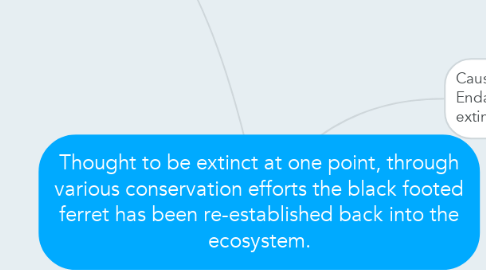
1. Conservation Methods
1.1. Group Organizations
1.1.1. That's why most of the 50 kits born in 2010 at the Smithsonian Conservation Biology Institute (SCBI) in Front Royal, Virginia, will pass through the Colorado center. Heim, Morgan. "Survival Training, Ferret Style." Smithsonian 41.10 (2011): 23. Academic Search Complete. Web. 25 Sept. 2014.
1.1.2. Ferrets get their first exposure to the elements, learn to navigate a burrow system (their natural habitation) and take their first crack at hunting prairie dogs
1.1.3. National Black-Footed Ferret Conservation Center run by the U.S. Fish and Wildlife Service (FWS) in Sybille, Wyoming, northeast of Laramie. And presently it is attending a boot camp of sorts. The prairie dog it snatched was already dead, and the entire food-catching exercise is part of a training program to give the ferret a taste of the wild before it's shipped off to the real world--to Mexico, for what scientists say is the most ambitious attempt yet to save North America's most endangered mammal. Aschwanden, Christie. "New Chance For Ferrets?." International Wildlife 31.5 (2001): 38. Academic Search Complete. Web. 24 Oct. 2014.
1.2. Breeding Efforts
1.2.1. Zoos
1.2.1.1. Today there are six facilities that make up the managed BFF Species Survival Plan®(SSP®). These include the U.S. Fish and Wildlife Service's National Black-footed Ferret Conservation Center (Colorado), National Zoo’s Smithsonian Conservation Biology Institute (VA), Louisville Zoological Garden (KY), Toronto Zoo (Ontario, Canada), Cheyenne Mountain Zoo (CO) and Phoenix Zoo (AZ). Omaha’s Henry Doorly Zoo participated in the SSP® until the late 1990s. "Captive Breeding." Black-footed Ferret Recovery Implementation Team. N.p., n.d. Web. 06 Nov. 2014.
1.2.1.2. Black-footed ferrets are seasonal breeders. Facilities begin checking both males and females for reproductive readiness in January. Since the SSP® is genetically a closed population (no new unrelated black-footed ferrets have been found since 1987) all pairings are done to minimize the loss of genetic diversity. The primary task of the SSP® is to produce as many kits as possible to support ongoing reintroduction efforts. Educating people about the BFF and prairie ecosystem is another import aspect of the SSP®.
1.3. Training Programs
1.3.1. In the past, researchers swooped down on ferrets with stuffed raptors and sent in "robo-badgers" to boost the ferrets' ability to defend themselves against common predators.
1.3.2. Living in outdoor pens, complete with prairie dog burrows, the ferrets at Sybille and other centers learn to live underground and hunt prairie dogs like their wild ancestors did.
1.3.3. But the most important part, Marinari says, involves live prey: "The more practice ferrets get going after prey, the better they do."
